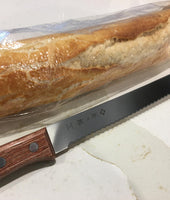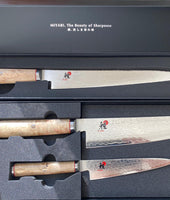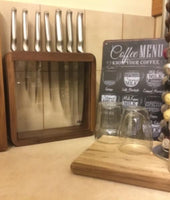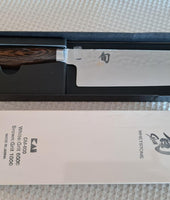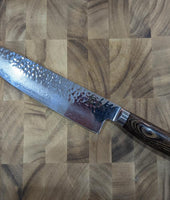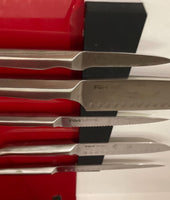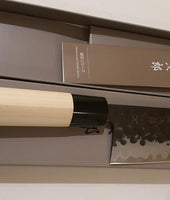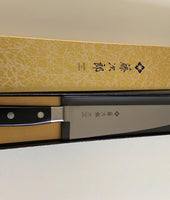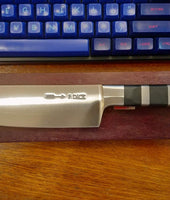Shun is one of the well-known brands in the kitchen cutlery industry, and Shun knives are one of the premier options in the market. There is a variety of them in the market, and this guide will help you find the best Shun knife set for your kitchen use.
What are Shun Knives?
The Shun brand name is derived from the Japanese’s word for the exact time in a season when the food is at its peak perfection. It is when fruits and vegetables are perfectly ripe, at their sweetest and when the meal is most flavorful. Any professional chef and home cooking enthusiast celebrates this time in the kitchen, and the Shun knife represents this peak perfection.
It calls on over a century of heritage in Japanese blade-making craftsmanship, bringing thinner, sharper, and lightweight blades to the market. These give the brand its characteristic high-performance edge over most other knives with their heavier blades.
Shun Cutlery is the maker of Shun Knives, and its parent Company Kai Group has been in the business of blade making since 1908. Kai Group is in Seki, which has been the home for Japanese blade making from swords to knives for over a thousand years. In 2002, it expanded its business and formed the Shun Cutlery intending to bring Japanese knives to the rest of the world, especially Western Europe. Shun knives are now sold in over 30 countries, but they still make them in Seki City.
All Shun knives are handcrafted to keep to the traditions of Japanese craftsmanship, of exceptional quality and high performance. The manufacturing process for each knife takes 100 individual steps, all by hand. The company then uses premium and modern material and state-of-the-art technology to produce the knives in numbers that meet the market’s demand.

Construction of Shun knives
Shun knives are constructed using various methods following the Japanese blade-making tradition. First, there is Damascus cladding which creates Damascus steel. Shun creates its Damascus by layering different metal layers together and then forges them into one steel.
The Damascus cladding process and the different characteristics of the metal alloys create the rippling patterns on the blade. The number of layers differs, but most Shun knives have 34 layers on each side, making it a total of 68.
The patterns become visible when the artisans grind the blade starting from the spine, which is the thickest point to the thinnest point at the edge. On top of the grinding, the craftsmen also acid etch or bead blast each blade. The layered metals react differently to the solution with the carbon steel darkening while the other metal alloys remain bright. It leads to a beautiful waves pattern on the sides of the blade.
The above process of creating knives is called 'Kasumi, ' meaning mist because the rippling pattern resembles mist. Kasumi produces knives that have a sharp edge and are easy to sharpen. It also makes the knives aesthetically pleasing, strong, and stain-resistant, all of which are properties a chef wants in a premier kitchen knife.
The other construction is Tsuchime. In Japanese, Tsuchime means hammered, and Shun’s Premier line and other exclusive collections feature hand-hammered blades. The tsuchime finish gives the knife a beautiful look reminiscent of ancient Japanese knives. On a functional note, the divots created by the hammering create air pockets that help reduce the drag.
Finally, Shun Knives are also created using the Sun Mai technique. In this method, a hard steel core of the blade is clad with softer steel on both sides, which offers support and protects the core against corrosion and chipping. In most Shun’s knives that use this method, the core is VG 10 stainless steel.
What are Shun Knives Used For?
Shun Knives, like any of those from any professional kitchen knife maker, cover all kinds of uses. If you want the proficiency of a chef, then you should buy a knife for every essential function in the kitchen. There are shun knives for all the kitchen functions, with the main ones being;
Shun Chef Knife , Shun Classic
Like any other chef knife, the Shun chef knife is quite versatile and a must-have in your collection. It does the heavy-duty tasks of mincing, dicing, and slicing around the kitchen. Shun Cutlery has several options for the chef's knife, including the Shun Classic White Chef knife.
It is 20cm long and has a white handle made from Pakkawood and a notable curved belly that allows cutting with a rocking motion. It also has a proprietary VG-MAX cutting core and 34 layers of stainless Damascus on both of its sides. You can also opt for the Shun Kai Seki Magoroku Benifuji Chef's Knife, which is 18 cm long and is made from 8A steel, and features a three-chamfering process that helps reduce friction between the blade and food.

Paring Knife
A paring knife's main attraction is its maneuverability, thanks to its small size. It is handy at cutting, chopping, and slicing fruits and vegetables. It is perfect for trimming and peeling jobs. Shun Cutlery has a couple of options, one of which is the Shun Kai Premier Tim Mälzer MINAMO Paring Knife with a blade measuring 9cm long.
It combines attributes from the Japanese Santoku and classic European chef's knife. The blade is made from VG-MAX steel (61 (±1) HRC) clad in 32 layers of Damascus steel. The ergonomic handle uses walnut wood, and the knife suits different cutting tasks, with the blade having the tsuchime treatment.

Utility Knife
The utility knife, as its name suggests, is the most versatile knife in the kitchen. It is helpful that it seems like a cross that is between a chef’s knife and the paring knife but with a straight and narrow blade. Its utility has people calling it a sandwich knife because they can prepare anything that makes up a sandwich.
One of the best Shun knives for this role is the Shun Classic White Utility which measures 15.2cm. It helps that it has a VG-MAX cutting core that is wear and corrosion resistant, and it is clad in 34 layers of Damascus steel.

Nakiri Knife
The Nakiri is the Japanese’s specialist vegetable knife. It has a unique rectangular shape that gives it a straight blade, spine, and edge. It does not call for a rocking motion, just a simple push cut. It is an excellent choice for salad preparation and slicing vegetables and will also make easy work of onions and vegetables of any kind.
Meat Cleaver
If you are putting up a collection of Shun knives, you should not leave this one out, especially if you will be cutting through bone and heavy meat sinews that need chopping up. The Shun Kai Classic Meat Cleaver is perfect for this function. Its blade is 18.7cm, and it is handy whether you are separating ribs or cutting down a chicken to size. The knife uses the proprietary VG-Max steel that is durable and provides excellent performance.

Boning Knife
Boning knives are excellent for all the tasks that require the precision and maneuverability that cutting around bones requires. They can also help with filleting fish if you do not have a filleting knife. It is marked by its unique narrow, sharp, and curved blade with a pointed tip.
An excellent example is the Shun Kai Classic Gokujo Boning Knife 15.2cm. The knife has the high-performance VG-Max steel and clad in Damascus blades. The D-shaped ebony PakkaWood handles complete the aesthetics while offering you comfort.

Shun Knife Sets
If you are looking for a set of knives, Shun Cutlery also has several. One of the interesting options is the Shun Kai Classic 3 Piece Santoku Knife Set. The set included a 3.5-inch paring knife, a 6.5-inch utility knife, and a 7-inch Santoku knife. All the knives are hand sharpened with a 16° double-bevel blade.

Another set you may want to consider is the Shun Kai Kanso Knife Block Set 7 Piece. This set contains four knives, honing steel, kitchen shears, and a solid knife block. The knives are a 6-inch paring knife, an 8-inch carving knife, an 8-inch Chef’s knife, and a 6 ½ -inch utility knife.
The blades are all made from Japanese AUS10A steel, which can hold its sharp edge longer and delivers high performance and precision cutting. The handles are made from tagayasan wood and have the right contouring to help with the grip. They also feature full-tang construction.

Tips for Using and caring for Shun Knives
If you want to keep your Shun Knives in top condition, you should know how to correctly use them and maintain them. Here is an overview of what to do;
· Cutting technique
When using a shun knife, you should use smooth slicing motions making movements like you were cutting with a handsaw. Start by pushing the knife forward and downward and then pull it back to your body.
The up and down chopping motion can only be used on the meat cleaver. Most Shun knives are for precision slicing, so only use the specialist knives for cutting through bones and joints. For harder foods or products with thick and tough rinds like pineapple and watermelons, the best knife is the Shun Classic Western Cook’s knife. It is sharpened to a wider angle than the rest allowing it to handle heavier foods better.
When cutting and the knife sticks in the blade, do not twist it as this could damage the blade. Instead, lift the knife up and continue cutting.
Use a soft cutting surface to protect the knife's edge. Medium softwoods and silicone or rubber boards allow the knife to hold its sharp edge longer. Avoid hardwoods, tiles, ceramic, and any kind of glass cutting boards.
Maintenance
Before using the shun knife for the first time:
- Wash it clean with hot water.
- After every use, clean the knives using running water and gentle soap. You should not use soap that has bleach or citric detergents.
- Proceed to rinse and dry the knife with a towel, immediately getting off all the water and moisture from the edge.
Suppose the knife has come into contact with any aggressive agent like lemon juice you should clean and dry it off immediately after use. You should not wash your knives in a dishwasher as it can damage the material and take off the edge.
If your knives have natural wood, you should not soak them in water. Periodically, you should coat the knife handle with neutral vegetable oil.
Storage
The best place to store is inside a wooden sheath after it is completely dry. Alternatively, you can store it in a wooden block or a wall-mounted magnetic knife board. You could also store the knife in a wooden drawer insert. Whatever your choice, do not store the knives in a way that their edges come in contact with other knives or cutlery.
Honing and sharpening
Sharpening takes metal off the edge of the knife to improve sharpness while honing realigns the blade’s edge to maintain a knife’s sharpness. Therefore, you should hone your shun kitchen knife more often, ideally weekly, and then sharpen it less often based on how often you use it and the volume and kind of work it does.
When you are sharpening, use a whetstone with grit that matches your blade's edge condition. Ideally, use honing and sharpening equipment from Shun Cutlery and follow the honing and sharpening guidelines.

Where can I Purchase Shun Knives?
We stock the best and widest collection of Shun knives and other Japanese knives and western knives too. We are your best option for genuine knives and knives accessories from the leading brands worldwide.
Our collection of Shun knives covers knives for every occasion, and with our ongoing sale, you can get them at affordable prices. You also have the option to pick a set of knives or single knives. Shop with us today and enjoy a seamless shopping experience as you get value for your money and genuine quality products.

Also Read: Everything You Need to Know About F. Dick Chef Knife
Explore our other products: Due Cigni Classica Full Tang Cleaver 16cm, Due Cigni Classica Full Tang Cleaver 18cm, and Due Cigni Filleting Knife 16cm.


























